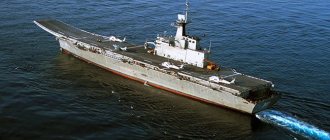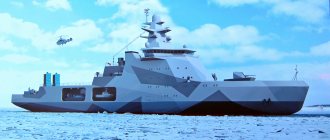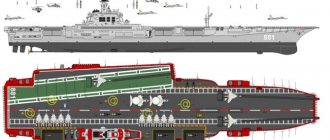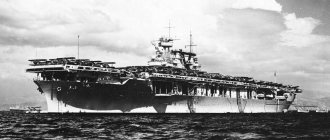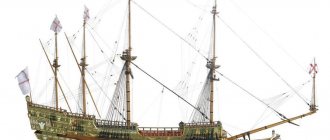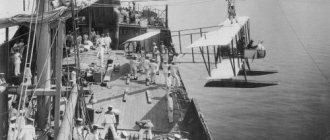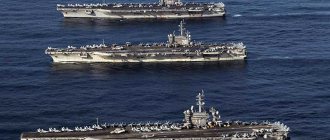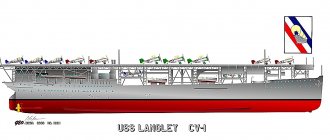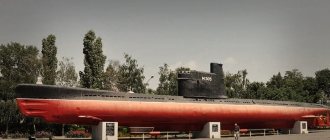Author: Great Mute
17 April 2022 12:32
Tags: Varangians how it works Liaoning facts photos
4396
8
Most recently, the world's attention was focused on the military parade organized by China. The demonstration of power turned out to be truly impressive: the PRC army looks capable of any accomplishment at the first order of the commander. Among other things, the Chinese aircraft carrier Liaoning entered the raid: it was supposed to be one of the highlights of the whole performance.
0
See all photos in the gallery
Many observers noted that, despite the external gloss, the ship's model is outdated and inferior to many ships of a similar type. Despite this, experts are confident that this aircraft carrier is designed to conduct combat operations on enemy territory. We tried to figure out what China’s only aircraft carrier is “made of” and how exactly it can be used in the event of a war.
Vessel history
0
“Varyag” - and this was the first name of the ship - left the Nikolaev shipyard back in 1985. For the next few years, he successfully served the dying Soviet Union. The collapse of the latter led to the division of the fleet: the Varyag went to Ukraine. The latter resold the ship to China, allegedly because the outdated model can no longer adequately perform the necessary functions. The Chinese, however, themselves assured that they were not going to use the Varyag as a combat vessel. Officially, the aircraft carrier was supposed to become a real floating entertainment center.
At sea and in the air
When you look at the Nimitz, you immediately notice the superstructure, which is moved to the side as much as possible: this is necessary so that there is as much free space on the deck as possible. On this “island” there is a flagship command post, running, operational and chart rooms. There are also flight control posts, an aircraft maintenance center, identification systems, and, in addition, traveling cabins for the commander and flagship. Note that the aircraft carrier uses the NTDS/ACDS combat information and control system. Tactical communications are provided, among other things, by a data exchange network such as Link 16. Satellite communications are supported by VHF transceivers, including WSC-3.
A bird's eye view is the best way to watch takeoffs and landings - another reason why all aircraft carriers have a superstructure on the deck. By the way, the Nimitz has a flat flight deck and four catapults. It is through the latter that planes are launched into the air. The principle of operation of the catapult is relatively simple: first, the aircraft is hooked to the accelerating device with its front landing gear, and then it is “shot” into the air. It's somewhat reminiscent of a slingshot. Catapults operate using steam, which, when launched, fills two cylinders where the pistons are located, connected by a special leash with a hook for aircraft. The catapult operator needs to take into account the size of the aircraft, wind speed and measure a number of other parameters. And only then the plane scatters across the deck and soars into the sky. The catapult ensures the takeoff of winged vehicles weighing up to 43 tons at a speed of about 300 km/h. Note that steam catapults are becoming a thing of history - on the new aircraft carrier Gerald R. Ford, their role will be played by electromagnetic catapults (EMALS).
F/A-18E Super Hornet takes off from the aircraft carrier Nimitz/ ©Wikipedia
The club of countries that own aircraft carriers is, for obvious reasons, small. Now it includes eight states, and four more have universal landing ships, which, with certain reservations, can also be classified as aircraft carriers. At the same time, even fewer countries in the world can build such ships on their own.
From the Nimitz, planes can be launched at intervals of only 20 seconds. But, of course, it won’t be possible to launch more than a few aircraft with such intensity. In general, Nimitz-class aircraft carriers can support approximately 120 sorties per day.
A particular difficulty is landing. The pilot needs to hook a special hook onto the cable on the deck of the ship. This is not always possible to do on the first try (after all, the winged car has limited fuel, and there is an ocean around it). During landing, the plane hooks one of three cables that are connected to the piston of the stopping device cylinder. This cylinder is filled with liquid, which, under the action of a piston, rises up the pipe to a valve that closes gradually as liquid enters.
Nimitz-class aircraft carrier / ©Navy
During “non-working” hours, aircraft do not sit idle on the deck, but are stored in internal hangars using special elevators. This is not surprising: after all, if you put the entire air wing on the flight deck, there will be almost no space left on it. In total, on a Nimitz-class ship, four elevators are provided for lifting aircraft onto the deck. There will be only three of them on the new aircraft carrier Gerald R. Ford.
As already noted, it is the aircraft that provide the Nimitz with its strike potential. The air group includes F/A-18 fighters, EA-6 Prowler electronic warfare aircraft, E-2C AWACS aircraft, C-2 Greyhound transport aircraft and Sea King helicopters. Of particular interest are the F/A-18E/F Super Hornet. These are very multifunctional vehicles: they can effectively combat air threats and strike on the ground. Maverick missiles, HARM, AGM-154 JSOW, JDAM and Paveway II guided bombs are just part of the aircraft's arsenal. Perhaps no other fighter in the world can boast such a variety of weapons. Soon, the early versions of the F/A-18 (C, D) will be completely replaced by the latest fifth-generation fighters, the F-35C, and this will further increase the overall potential of the Nimitz aircraft carrier. The F-35C aircraft will also be part of the Gerald R. Ford class aircraft carrier air group.
F-35C / ©Navy
Modernization
0
Despite all the assurances of the authorities, the aircraft carrier, immediately after acquisition, was driven to a specialized military shipyard in Dalian. For six years, from 2005 to 2011, the former Varyag was cleaned and modernized. The power plant and heavy equipment have changed, new generation radars have appeared, and weapons systems have been installed most recently. And only at the end of the modernization, when it was already clear to everyone that there would be no entertainment platform, the Chief of the General Staff of the People's Republic of China, General Chen Bingde officially confirmed: the ship was being commissioned as a combat aircraft carrier.
Flight decks
Today, the flight deck of an aircraft carrier can be either flat or with a ski-jump. Ships with a flat deck are designed to accommodate horizontal take-off aircraft. Special catapults are used to lift into the air. Aircraft-carrying landing ships, designed to accommodate helicopters and vertical take-off aircraft, also have a flat flight deck.
But vertical and short takeoff and landing aircraft are based on ships with a deck equipped with a springboard. The runway and landing strip are interconnected. This type of flight deck is typical for aircraft carriers of the fleets of Great Britain, India, Italy, Spain, Thailand and Russia.
In the 20s - 30s of the last century, there were several aircraft carriers with a multi-level deck. It looked like this: a short take-off deck located in the bow of the hull (or a launch pad in the front of the hangar), and a flight deck on top of the hangar, used mainly for landing.
Practice has shown the disadvantages of such a deck structure, and by the end of the 30s, aircraft carriers with such a deck were re-equipped.
The basis
0
Now the PRC has an aircraft carrier quite comparable to the Russian Admiral Kuznetsov. In fact, these are vessels of the same type, with almost identical basic characteristics of speed and size. Even the take-off platform for aircraft is made in the same style. The main differences relate to weapons systems and electronic equipment: the Chinese preferred to block the Granit missile launch silos in order to gain more space for aircraft parking.
Controversy surrounding the project
The leadership of the Naval Academy actively advocated for the construction of a new type of cruisers. In addition, supporters of the project were the Navy Bureau of Aeronautics (its representative, Rear Admiral William Moffett, achieved the adoption of the above-mentioned 25 percent limit in London), as well as the Bureau of Construction and Repair. The activity of the latter was largely explained by the fact that in the second half of the 20s there was a lull in American shipbuilding, and designers, roughly speaking, had nothing to do...
The final sketch of the preliminary design of an aircraft-carrying cruiser with a standard displacement of 10,000 tons, presented by the Bureau of Shipbuilding and Repair. Source: R. D. Layman and Stephen McLaughlin. The Hybrid Warship
The project also had opponents - first of all, the so-called “Cannon Club” (an informal community of the most influential American admirals). Their objections were expressed most clearly and in detail by the commander of the Battle Forces Squadron, Admiral Frank Schofield, in a letter to the Chief of Naval Operations dated September 30, 1930.
Rear Admiral William Moffett. Source – en.wikipedia.org
Schofield pointed out that the capabilities of “hybrid” cruisers were greatly overestimated by the academy’s calculations, and the presence of a large amount of aviation gasoline on the ship would inevitably lead to a high fire hazard, which would become an obstacle to its use in artillery combat. This was an absolutely fair remark, but Schofield went on to argue that an aircraft-carrying cruiser would be forced to operate separately from the main squadron (which was the traditional approach to using aircraft carriers at that time), requiring a separate escort for itself, which would make it a burden for the squadron.
Admiral Frank Schofield. Source – en.wikipedia.org
Schofield did not explain why an escort was needed for a “low-value” ship and why it would have to be separated from the squadron even outside of an artillery collision. Subsequently, from the arguments of opponents of the project, mention of the fire hazard of gasoline completely disappeared, but an emphasis appeared on the need to provide the ship with an escort and the low efficiency of carrier-based aircraft. Obviously, the admirals did not like the deck cruiser itself, but the idea of an aircraft carrier cruiser in principle.
Characteristic are the arguments of Schofield's closest subordinate, the commander of the destroyer forces of the Squadron, Rear Admiral Eduard Kalbfuss. In his extensive and very convincing theses, he did not mention a word about the danger of gasoline fire, but he talked at length about the inevitable limitation in the use of artillery due to the presence of aircraft. Indeed, spotter seaplanes on all ships of that time greatly interfered with shooting. But Kalbfus chose not to mention the fact that in that era they were placed on ships on a residual basis and interfered with absolutely everything. He emphasized that in a combat situation, a cruiser with a flight deck would be useless or defective - a statement that may be fair, but not verifiable in peacetime. Moreover, Kalbfus directly admitted that it was in peacetime that such a ship would demonstrate many capabilities and attract the attention of both theorists and practitioners - this is what he saw as the main evil of the project.
Rear Admiral Eduard Kalbfus. Source – en.wikipedia.org
However, Admiral William Pratt, appointed head of the Naval Operations Division in 1930, turned out to be a supporter of the “cruiser-aircraft carrier” project. In 1929, while the fleet was working on repelling an attack on the Panama Canal, Pratt became convinced of the effectiveness of naval aviation and has since become an ardent admirer of it. As a result, thanks to his persistence, the experimental “cruiser with a flight deck” was included in the 1933 shipbuilding program.
Alas, the program immediately suffered from the outbreak of the economic crisis and reductions in appropriations for the fleet. In 1932-1933, not a single cruiser was laid down for the American fleet - more precisely, at the very end of 1933, the heavy New Orleans was laid down, but already according to the 1934 program. But in the same year, 1933, several other events occurred that radically affected the fate of the project. In April, Admiral Moffett was killed during the crash of the Macon airship, and in June Admiral Pratt was removed from his post. The final chord was the removal of Admiral Lanning from the post of head of the Naval Academy, and he was replaced in this position by none other than Schofield’s protégé, 56-year-old Admiral Kalbfuss. This happened on June 18, 1934.
The appointment of a person as head of the academy who openly states that the experiment is harmful because it confuses minds looks very strange. Note that the future Admiral Raymond Spruance, who served as an employee of the academy in those years, publicly expressed an extremely low opinion of Kalbfuss’s analytical abilities and his work on naval theory (“On Making a Decision for an Operation”), written during the period of leadership of the academy. In January 1938, Kalbfus was promoted to full admiral and appointed commander of the Line Forces Squadron, but after a year and a half he was again transferred to the position of head of the academy. At the end of 1941, he was retired due to age, and during the war he was a member of the General Council of the Navy and the investigative commission on the Pearl Harbor case, but was not involved in operational work.
In 1934, Schofield managed to win over the new commander of naval aviation, Admiral Reeves, to his side, and the aircraft-carrying cruiser project was finally “cut down” in the General Council of the Fleet. An additional “nail in his coffin” was Japan’s announcement of withdrawal from the Washington Treaty, made on December 29, 1934. This event eliminated one of the main motivations for designing cruisers with a flight deck, and the Bureau of Design and Repair found itself up to its necks with a new shipbuilding program.
Sketch of the project for a “cruiser with a flight deck” with a standard displacement of 12,000 tons and with one three-gun 203 mm turret, December 1939. Source – Spring Styles Book, US Naval Historical Center Photograph
Nevertheless, the development of an aircraft carrier cruiser gradually continued on a proactive basis. In new versions of the project, the number of artillery was reduced while the air group and the length of the flight deck were increased. Moreover, new calculations showed a higher efficiency of 203 mm guns than previously assumed. As a result, the new project carried either two 152 mm three-gun turrets (in the bow and stern), or only one 203 mm (in the bow). Obviously, this armament was too weak for cruising combat, and even strengthening the waist armor to 127 mm along with an increase in displacement to 12,000 tons did not save the situation - the ship continued to remain an inferior aircraft carrier, sharply deteriorating its cruising qualities and at the same time becoming more expensive.
Sketch of the project for the “flight deck cruiser” CF-2 with a standard displacement of 12,200 tons and two three-gun 152 mm turrets, January 1940. Source – Spring Styles Book, US Naval Historical Center Photograph
Having information about the course of the war in the Pacific Ocean, today we can state that in its first period, a “cruiser with a flight deck” could turn out to be very, very useful to the American fleet - primarily as a means of reconnaissance and air cover for small cruising groups. Undoubtedly, a light, high-speed aircraft carrier would have been even better suited for such a purpose, but there were no such ships in the American Navy at that time; moreover, they were not even designed in the early 30s. In addition, at the beginning of 1942, the striking power of aircraft carriers was largely limited by the number of trained pilots, and the total formal number of aircraft played a less noticeable role.
Finally, such a cruiser would come in handy as a ship for local reconnaissance and search operations when there is an acute shortage of artillery support forces. It would have been very useful in early 1942 during hit-and-run operations against Japanese island bases. And to fight German and Japanese auxiliary cruisers, where a combination of active aerial reconnaissance with artillery power was required, such a ship would be simply irreplaceable. Note that even as a raider, a cruiser with a flight deck, with its designed range of 10,000 miles, could deploy in all its glory. Thus, it was precisely for the initial period of World War II that such ships - contrary to the theses of Admiral Kalbfuss - would have had considerable combat value.
